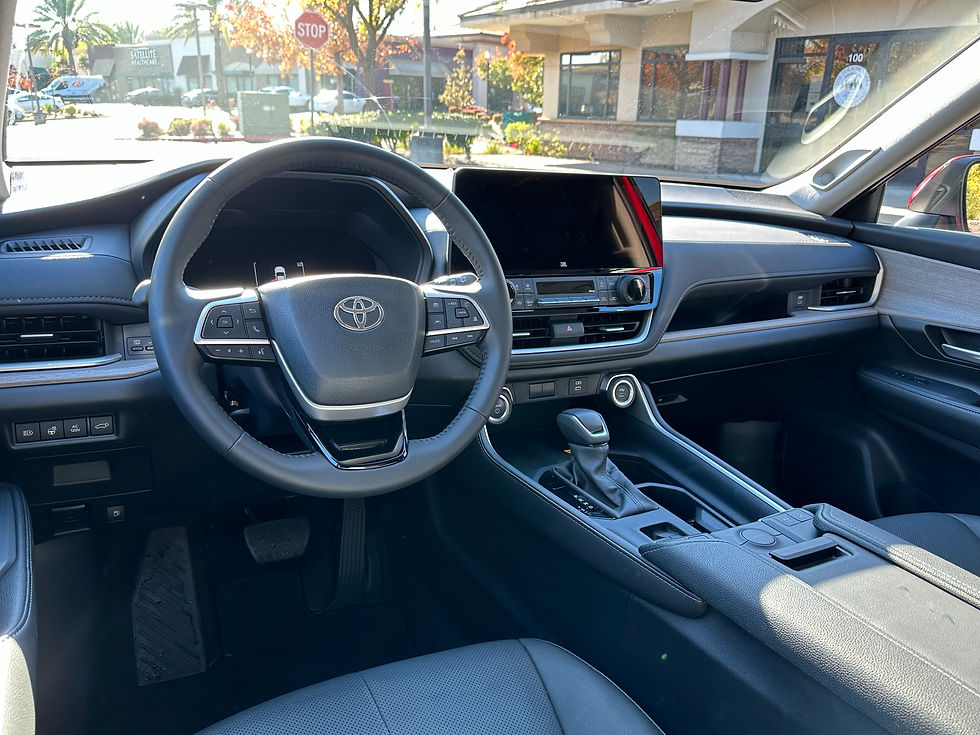Adjectives in Automobiles: The 2024 Toyota Grand Highlander Hybrid
- Mike Hagerty
- Dec 12, 2023
- 3 min read
Updated: Dec 31, 2024

Toyota, the brand that once upon a time created names out of thin air (Camry, Celica, Corolla), now joins the list of automakers who, presented with an extension of a product line---a larger or fancier model of an existing nameplate, said "let's just call it Grand (name)": Pontiac Grand Prix.
To say nothing of less well-remembered "Grand"s...Pontiac Grand Ville and Grand Am, Suzuki Grand Vitara, Chrysler Grand Voyager, Dodge Grand Caravan, plus any number of Grand Touring trims of other models.
Original? No. But it won't hurt Toyota a bit.

The Toyota Grand Highlander slots in between the Highlander and the Sequoia...a sweet spot in the SUV segment currently being exploited very profitably by the Kia Telluride. More than anything, the Grand Highlander exists to defend against that one vehicle, and the dimensions tell the tale---5.7 inches longer and an inch taller than the Kia.
The Grand Highlander is built on a lengthened and strengthened version of the Highlander platform, with a redesigned rear suspension allowing for maximum third-row seating comfort and interior cargo room. With the second and third rows folded, the Grand Highlander can swallow 11.0 more cubic feet of cargo than the Tellruide can.


There are three ways to power a Grand Highlander. One is with a 265-horsepower gasoline- powered 2.4-liter turbo four. That's called a Grand Highlander. Another is the Grand Highlander Hybrid Max. Shared with the most powerful version of the Crown sedan, it packs 362 horsepower and 400 lb-ft of torque.
Our tester was the middle---the Grand Highlander Hybrid. A 2.5-liter four-cylinder combined with an electric motor for 245 horsepower and an EPA-estimated 34 miles per gallon combined city/highway.





There are seven possible trim levels of Grand Highlander. Gasoline-powered models have XLE, Limited and Platinum. Hybrid models like our tester are XLE or Limited and Hybrid MAX models are Limited or Platinum.
Ours was a Hybrid Limited. Base price including destination of $52,455, and a fairly massive list of standard equipment at that price---Toyota's comprehensive active safety suite, 20-inch wheels, LED headlights, taillights and fog lights, smart key, pushbutton start, heated outside power mirrors, rain-sensing wipers, a hands-free liftgate, a 12.3-inch touchscreen with an 11-speaker JBL audio system featuring wireless Apple CarPlay and Android Auto, leather-trimmed heated and ventilated power front seats, heated second row outboard seats, a heated steering wheel, a fold-flat 60/40 split third-row seat, built-in second-row window shades, three-zone automatic climate control, wireless phone charging, a 1,500-watt inverter with two 120V AC outlets and (drum roll)----13 cupholders.



In fact, the extra-cost options on our tester were limited to two---the Ruby Flare Pearl paint job ($425) and carpeted floor and cargo mats ($358), which brought the bottom line on the window sticker to $53,238.


In a coincidence of the calendar, I also had the '24 Telluride for three of the days I had the Grand Highlander (look for the review next week). I like them both a lot. But---the as-tested price of the Grand Highlander Hybrid is $1,212 less than that of the Telluride, and the V6 in the Kia is only good for 20 MPG combined city/highway. The EPA estimates a $5,500 difference in fuel costs between the two over five years. Toyota may be playing catch-up here, but it's making a very strong first impression.


